
A flag is a piece of fabric with distinctive colours and design. It is used as a symbol, a signalling device, or for decoration. The term flag is also used to refer to the graphic design employed, and flags have evolved into a general tool for rudimentary signalling and identification, especially in environments where communication is challenging. Many flags fall into groups of similar designs called flag families. The study of flags is known as "vexillology" from the Latin vexillum, meaning "flag" or "banner".

The labarum was a vexillum that displayed the "Chi-Rho" symbol ☧, a christogram formed from the first two Greek letters of the word "Christ" – Chi (χ) and Rho (ρ). It was first used by the Roman emperor Constantine the Great.
The Roman legion, the largest military unit of the Roman army, was composed of Roman citizens serving as legionaries. During the Roman Republic the manipular legion comprised 4,200 infantry and 300 cavalry. After the Marian reforms in 107 BC the legions were formed of 5,200 men and were restructured around 10 cohorts, the first cohort being double strength. This structure persisted throughout the Principate and middle Empire, before further changes in the fourth century resulted in new formations of around 1,000 men.

A banner can be a flag or another piece of cloth bearing a symbol, logo, slogan or another message. A flag whose design is the same as the shield in a coat of arms is called a banner of arms. Also, a bar-shaped piece of non-cloth advertising material sporting a name, slogan, or other marketing message is also a banner.
Flag terminology is the nomenclature, or system of terms, used in vexillology, the study of flags, to describe precisely the parts, patterns, and other attributes of flags and their display.

A vexilloid is any flag-like (vexillary) object used by countries, organisations, or individuals as a form of representation other than flags. American vexillologist Whitney Smith coined the term vexilloid in 1958, defining it as
An object which functions as a flag but differs from it in some respect, usually appearance. Vexilloids are characteristic of traditional societies and often consist of a staff with an emblem, such as a carved animal, at the top.

A war ensign, also known as a military flag, battle flag, or standard, is a variant of a national flag for use by a country's military forces when on land. The nautical equivalent is a naval ensign. Under the strictest sense of the term, few countries today currently have distinct war flags, most using a flag design that is also the state flag or general national flag for this purpose.
Vexilla regis prodeunt is a Latin hymn in long metre by the Christian poet and saint Venantius Fortunatus, Bishop of Poitiers. It takes its title from its incipit.
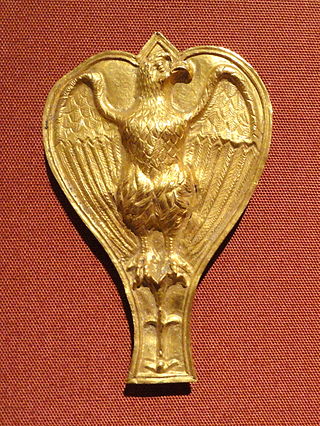
An aquila was a prominent symbol used in ancient Rome, especially as the standard of a Roman legion. A legionary known as an aquilifer, the "eagle-bearer", carried this standard. Each legion carried one eagle.

A signifer was a standard bearer of the Roman legions. He carried a signum (standard) for a cohort or century. Each century had a signifer so there were 60 in a legion. Within each cohort, the first century's signifer would be the senior one. The -fer in signifer comes from ferre, the Latin for 'to bear' or 'to carry'.
A vexillatio was a detachment of a Roman legion formed as a temporary task force created by the Roman army of the Principate. It was named from the standard carried by legionary detachments, the vexillum, which bore the emblem and name of the parent legion.

The gonfalon, gonfanon, gonfalone is a type of heraldic flag or banner, often pointed, swallow-tailed, or with several streamers, and suspended from a crossbar in an identical manner to the ancient Roman vexillum. It was first adopted by Italian medieval communes, and later, by local guilds, corporations and districts. The difference between a gonfalon with long tails and a standard is that a gonfalon displays the device on the non-tailed area, and the standard displays badges down the whole length of the flag.
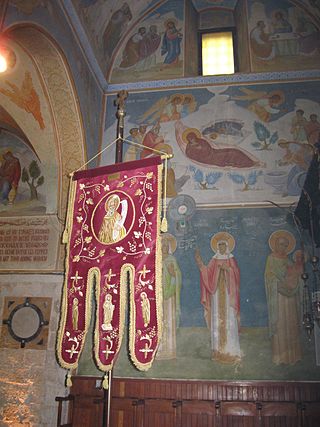
Khorugv is a religious banner used liturgically in the Eastern Orthodox and Eastern Catholic Churches.
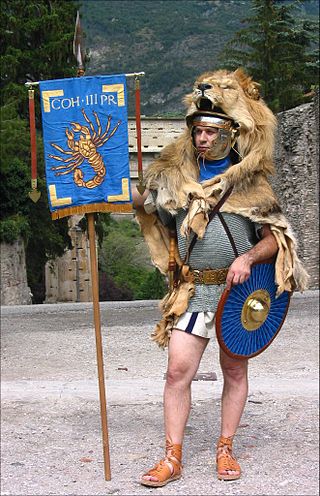
Vexillarius is a term referring to one of several distinct types of Roman soldier.

Throughout most of the history of Poland, the banner of Poland was one of the main symbols of the Polish State, normally reserved for use by the head of state. Although its design changed with time, it was generally a heraldic banner, i.e., one based directly on the national coat of arms: a crowned White Eagle on a red field. The banner should not be confused with the flag of Poland, a white and red horizontal bicolor, officially adopted in 1919.
For most of its history, the Eastern Roman (Byzantine) Empire did not use heraldry in the Western European sense of permanent motifs transmitted through hereditary right. Various large aristocratic families employed certain symbols to identify themselves; the use of the cross, and of icons of Christ, the Theotokos and various saints is also attested on seals of officials, but these were often personal rather than family emblems. Likewise, various emblems were used in official occasions and for military purposes, such as banners or shields displaying various motifs such as the cross or the labarum. Despite the abundance of pre-heraldic symbols in Byzantine society from the 10th century, only through contact with the Crusaders in the 12th century, and particularly following the Fourth Crusade (1202–1204) and the establishment of Frankish principalities on Byzantine soil from 1204 onwards, did heraldic uses penetrate in Byzantium. A native Byzantine heraldry began to appear in the middle and lower rungs of aristocratic families in the 14th century, coinciding with the decline of imperial authority and with the fragmentation of political power under the late Palaiologan emperors. However, it never achieved the breadth of adoption, or the systematization, of its Western analogues.

Roman military standards were emblems adopted by units of the Roman army. There were three main types of standard. Several throughout its history include:
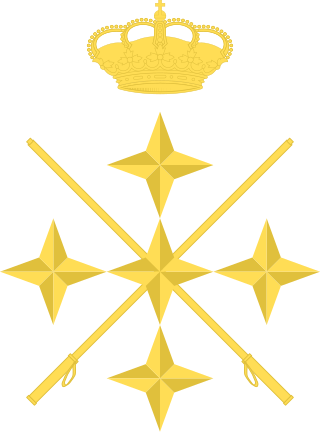
An insignia is a sign or mark distinguishing a group, grade, rank, or function. It can be a symbol of personal power or that of an official group or governing body.
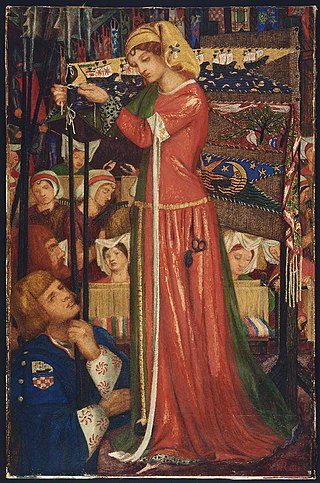
A flag is a distinctive piece of fabric used as a symbol, a signalling device, or for decoration. While the origin of flags is unknown, flag-like symbols have been described as far back as 11th century BC China and have been used by other ancient civilisations such as Egypt and Rome.

Festival totems are decorative objects, signs, toys, or symbols prominently displayed on poles by attendees at various music festivals and cultural events worldwide. Often seen in the crowds and campsites at large outdoor festivals, festival totems serve various purposes, ranging from artistic expression to utilitarian practical navigation and communication in large crowds. Typically, totems are DIY projects created by festival attendees, which are made from a variety of crafting materials and updated to reference current events, memes, music, or a festival, but have also recently become available to purchase online from totem creation companies.

















